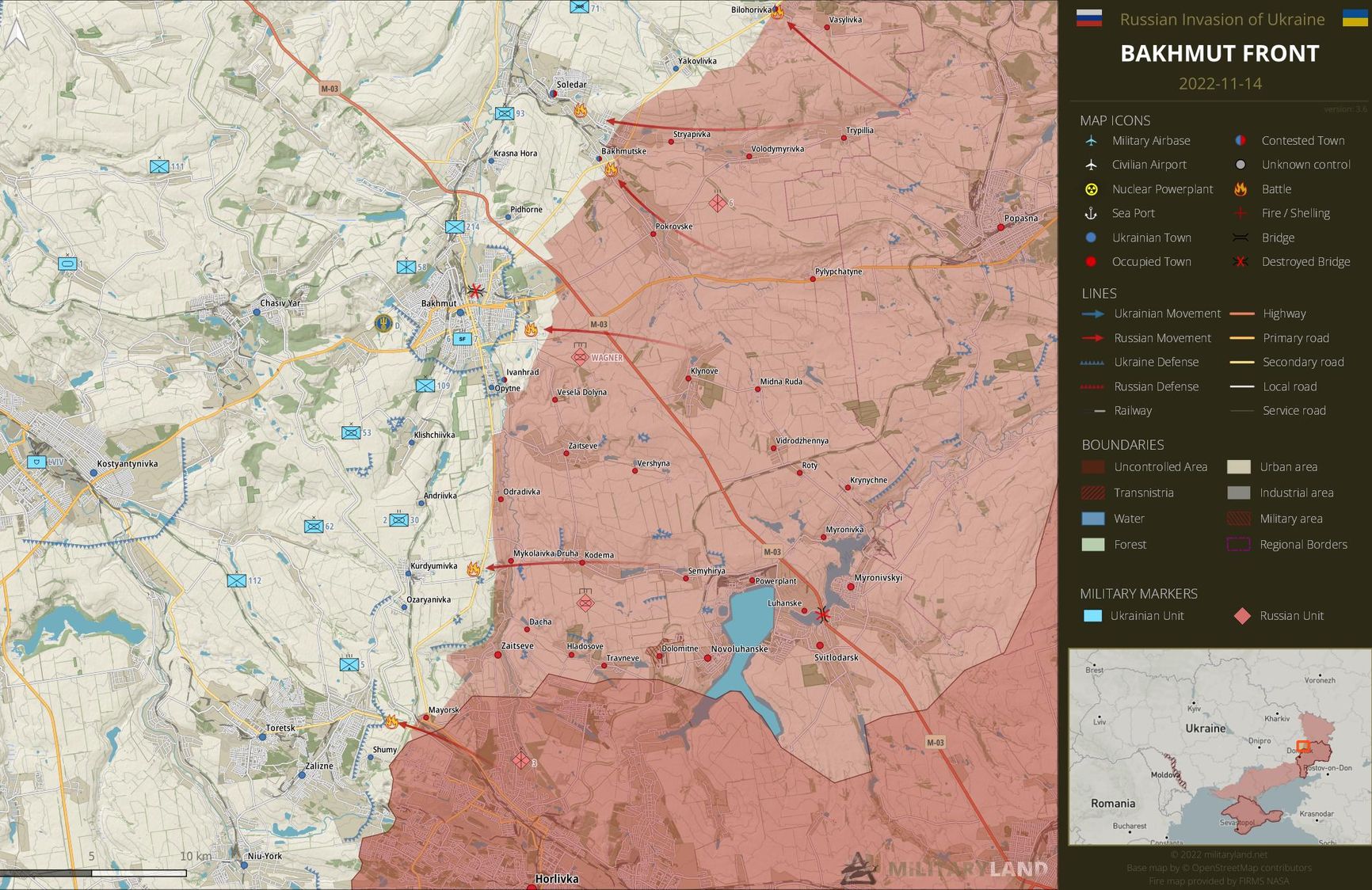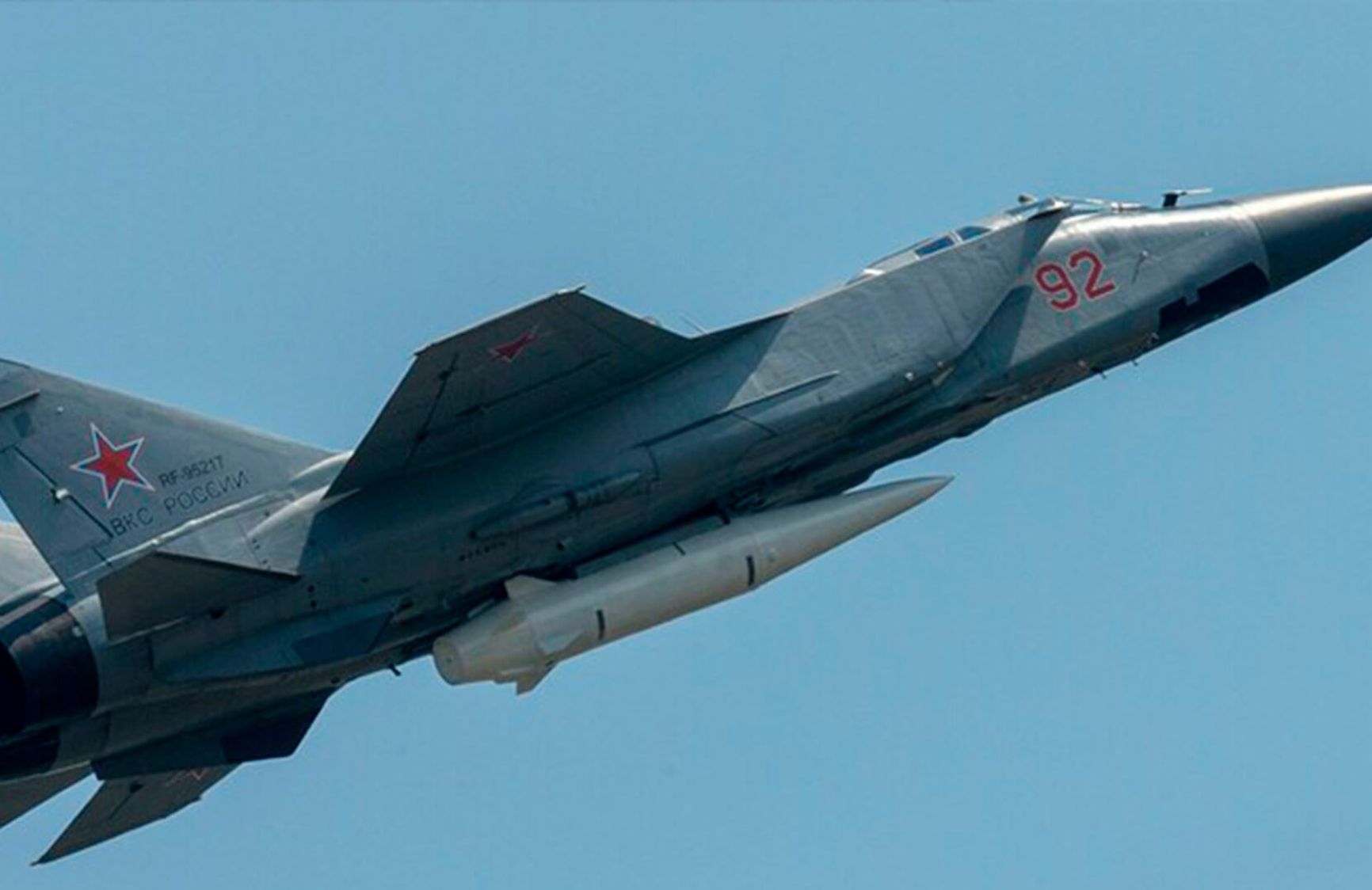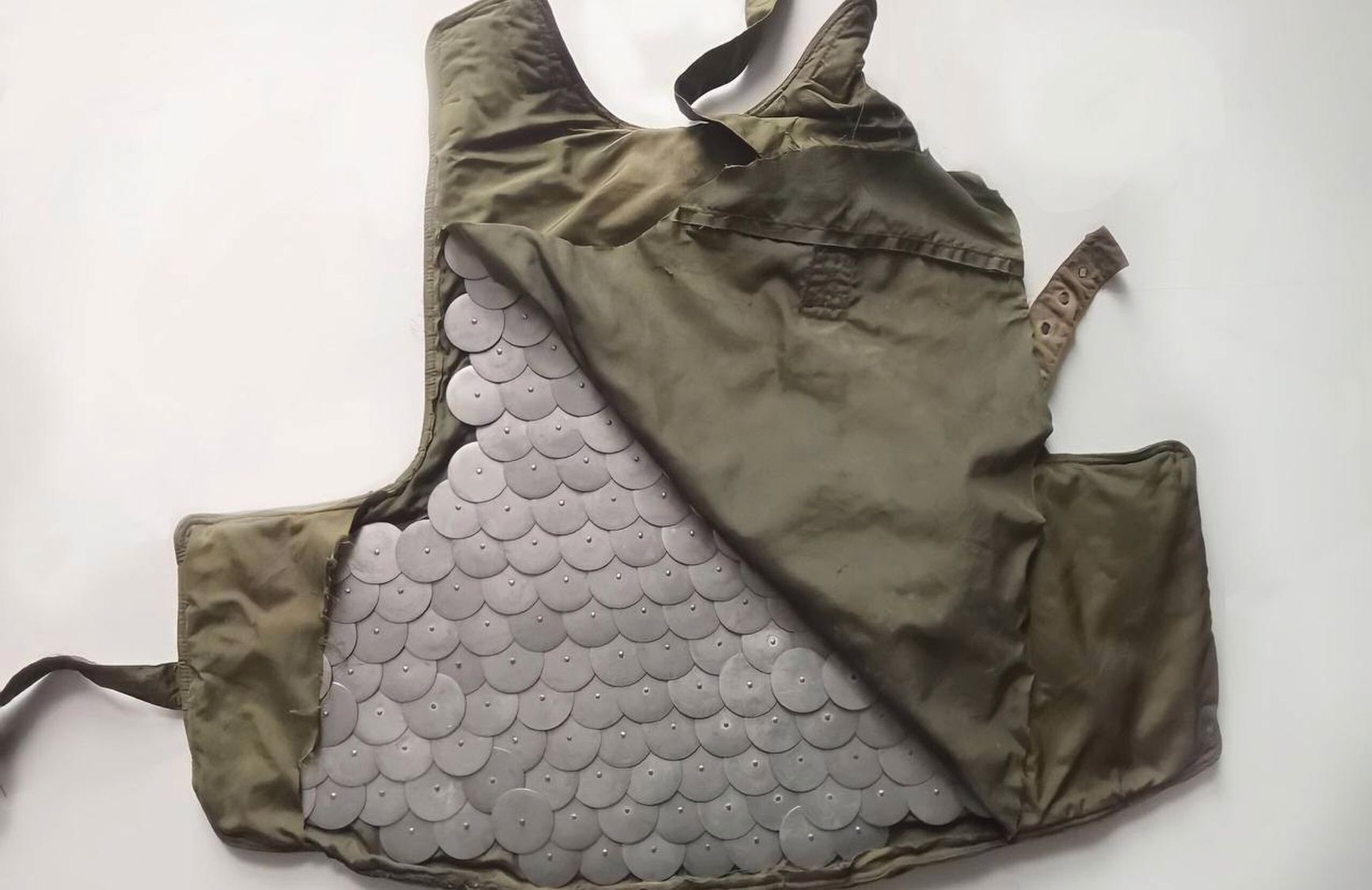
The front line
There were no particular changes in the Kherson direction – mutual shelling was recorded without any serious advances. At the same time, the Russian military also continued to bomb Kherson itself – witnesses published a video of the smoking Kherson administration building. Kyrylo Tymoshenko, deputy head of the Office of the President of Ukraine, reported that Kherson was hit by multiple rocket launchers (MLRS) around 11:00 a.m. on December 14. Two floors were damaged as a result of the hit on the Kherson administration building. According to preliminary reports, there were no casualties.
There were no changes on the Zaporizhzhia front – exchanges of artillery strikes were recorded. In the Vuhledar direction, according to the Russian propaganda Telegram channel Rybar, the Russian army switched from the offensive to the defensive after an unsuccessful attempt to storm the village of Velyka Novosilka.
Heavy fighting continues in the Bakhmut direction. Russian pro-war and propaganda channels wrote about a sweep of Opytne, the southern suburb of Bakhmut. Military correspondent Yuri Kotyonok published a statement on behalf of Yevgeny Prygozhin – the founder and head of the Wagner Private Military Company (MPC) – who said that the Ukrainians are putting up “resistance of a level that has probably never been seen before in the history of the last century.” At the same time, it is too early to talk about the capture of Opytne by Russia, according to the statement. Rybar also wrote that Ukraine is preparing a counteroffensive.
Another Russian propagandist, Boris Rozhin, claimed that the Armed Forces of Ukraine’s (AFU) defenses near Bakhmut are “crackling and slowly buckling.” However, according to Rozhin, “it is, to put it bluntly, premature to speak of a breakthrough or a defensive collapse.” Igor Strelkov (Girkin) – a convicted war criminal – noted that officially Russian troops “have taken” Opytne “for two weeks already,” so they now refer to the fighting as “sweeping the area.” According to Girkin, neither side is making any significant tactical progress. The same is true for the Svatove-Kreminna line, where no changes were observed.

In the Donetsk direction, fierce fighting is going on in Marinka. The Russian military has the advantage in this location – according to WarGonzo, the Telegram channel of self-styled “war correspondent” Semen Pegov, the Ukrainian garrison in Marinka is in “critical condition.” Igor Girkin called it a “tactical level meat grinder.”
The Belarusian Defense Ministry, meanwhile, published a video of the movement of mechanized units. The pro-Russian Telegram channel Voennyi Obozrevatel (“Military Observer”) reported that the maneuvers are linked to a sudden “test” of the troops' combat readiness. Girkin wrote that the active movements of Russian and Belarusian troops may be related to preparations for an offensive or an attempt to divert AFU forces to the north.
Military equipment is also being moved at full speed: according to Belarusian Hajun, the media project of military journalist Anton Motolko, a Russian A-50U airplane, used for aerial reconnaissance and target designation, landed in Belarus. The A-50U “Sergey Atayants” long-range radar detection and control aircraft with registration number RF-93966 came in for a landing at the Machulishchy airfield around 14:27 Kyiv time (15:27 Moscow time) on December 14.
Three MiG-31Ks of the Russian Air Force were also deployed to Belarus, landing at the military airfield in Machulishchy, reported Belarusian Hajun. The MiG-31K can carry “Kinzhal” hypersonic aeroballistic missiles and is able to launch them at a distance of 2,000 kilometers (approximately 1,250 miles).

glavcom.ua
Geran-2 drones shell Kyiv and surrounding region
The Iranian Shahed-136 drone, renamed by Russia as the Geran-2, again appeared in Kyiv and the Kyiv region after a long absence. According to the mayor of the capital, Vitaly Klitschko, Kyiv’s air defense forces managed to shoot down 10 of the drones that flew in, but did not say how many UAVs were involved in the raid in total.
Volodymyr Zelensky later clarified that all 13 drones that flew into the Kyiv region were shot down. A UAV attack was also expected in the Zhytomyr region, local authorities said. The AFU’s Air Force Command reported that Russia was launching drones from the eastern coast of the Sea of Azov. AFU radars detected over ten barraging munitions and destroyed them.
Losses
The Russian Defense Ministry claimed in its official Telegram channel that up to 50 Ukrainian servicemen, one tank, three armored fighting vehicles and four pickup trucks were destroyed in the Donetsk direction. The Defense Ministry also claims that up to 80 Ukrainian servicemen, three armored combat vehicles and four vehicles were «destroyed» near the settlements of Novosilka and Prechystivka in the so-called «DPR,» and that a US HIMARS multiple rocket launcher was allegedly intercepted near the settlement of Kreminna in the «LPR.»
The Ukrainian side reported confirmation of the December 12 defeat of a Russian army staging area near Verbove in the Zaporizhzhia region. Up to 10 units of weapons and military equipment of various types were destroyed, casualties among servicemen are being specified, according to an evening summary issued by the AFU General Staff. On December 14, Ukrainian aviation carried out seven strikes on personnel, weapons and military equipment concentration areas, and three strikes on the positions of anti-aircraft missile systems of the Russians, the summary said.
Armaments, military and special equipment
Oleksiy Danilov, Secretary of the National Security and Defense Council of Ukraine, said that Ukraine will now be able to produce 152 and 122 mm shells on its own. The production of mines and other ammunition has also been launched, according to Danilov. “We are talking about thousands - this is already an industrial scale,” Danilov said.
Long-range artillery firing 155-mm shells used to be supplied to Ukraine by NATO countries, while 152-caliber shells – a legacy of the USSR – had to be brought in from the warehouses of the former Warsaw Pact countries or states that once received them from the Soviet Union. But these stocks are continuously running out, so Ukraine's own production plays a huge role in arming the Ukrainian forces. In April, Defense Minister Oleksii Reznikov announced that the Ukrainian army was officially transitioning to the NATO standard of 155mm caliber weapons.
On December 13, a CNN report revealed that the Pentagon intends to supply Patriot air defense systems to Ukraine, with the decision being “finalized” and a decision may be announced as early as this week. With the US close to a decision on the Patriot, reports also revealed that Italy would supply similar SAMP/T systems.
Military analyst Kirill Mikhailov noted in a conversation with The Insider that the supply of these systems to Ukraine will help strengthen the country's air defense and protect against ballistic missiles, which Iran intends to supply to Russia.
“As for the Patriot – this is one of the best, most powerful and longest-range systems in the NATO arsenal, the supply of these complexes to Ukraine will allow to cover additional directions, to transfer Soviet complexes like the BUK and S-300 closer to the front line and use them more actively to counteract the Russian frontline aviation. For example, a Wagner Group Su-24M jet was recently shot down. In addition, Patriot systems can counter ballistic missiles to a certain extent, as was demonstrated during the Gulf War, when they intercepted Soviet missiles used by Saddam Hussein's regime with some success. Although, of course, it is not known how effective that was – the exact data is still classified. But it’s clear that since then they’ve probably tried to modernize that and correct the flaws.
This is important in the context that Iran is going to supply Russia with its own ballistic missiles. As Yuriy Ignat, spokesman for the Ukrainian Air Force, said, the AFU now has no defense against such missiles, while it has [defenses] against the cruise [missiles] with which Russia strikes civilian infrastructure [in Ukraine]. This was noticeable when there were very serious problems with intercepting Russian Iskander ballistic missiles, but it is likely that they've almost run out [of them], as are the older Tochka missiles. Iranian missiles will help strengthen strikes against Ukrainian infrastructure, and that's what the Patriot can fight against.
As for the SAMP/T – these are also quite strong air defense systems, I think even more effective than the same Soviet S-300, although nominally they seem similar in [their] characteristics. In any case, these modern systems are very much praised, like the IRIS-T or the NASAMS. These supplies will allow [Ukraine] to protect major cities and infrastructure more effectively.”
“An African country” may also start supplying weapons to Ukraine, the Czech company Excalibur Army, which is engaged in the modernization of T-72 tanks, announced. The unnamed country (most likely Morocco) previously ordered 30 such tanks, but decided to transfer them to the AFU. Taking into account the decision, the company may modernize and supply 120 tanks, instead of 90 as originally planned. The African country will receive other company products in return.
“The first five tanks for Ukraine will be received next week, and we want to deliver 18 units by the end of the year,” the director of the Czech company said.
Chain mail vest from 1974
The AFU found a Russian armored vest resembling chain mail in one of the liberated villages in the Mykolayiv region. Details about the vest, along with a photo, were published by Ukraine’s Operational Command South.
“During the liberation of villages in the Mykolayiv region, the 59th separate motorized infantry brigade named after Yakov Gandzyuk came across an interesting find. In one of the private homes that had been seized by the Russian occupiers, among other things left behind by the enemy, were several Soviet ZZL-74 body armor vests. This body armor was developed in 1974 to replace the then outdated ZZT-71 M. It was based on the so-called scale pattern of 50 mm diameter, 2 mm thick elements arranged in two rows.

The characteristics of the “modern” Russian bulletproof vest indicate the reliable protection of its owner against a blow from a knife, a shank, an awl or a spike. Among the additional characteristics, one can highlight the significant weakening from blows from stones, axes, crowbars, and other weapons that rely on percussive-fractional action due to the rigidity of the whole construction and its parts.”